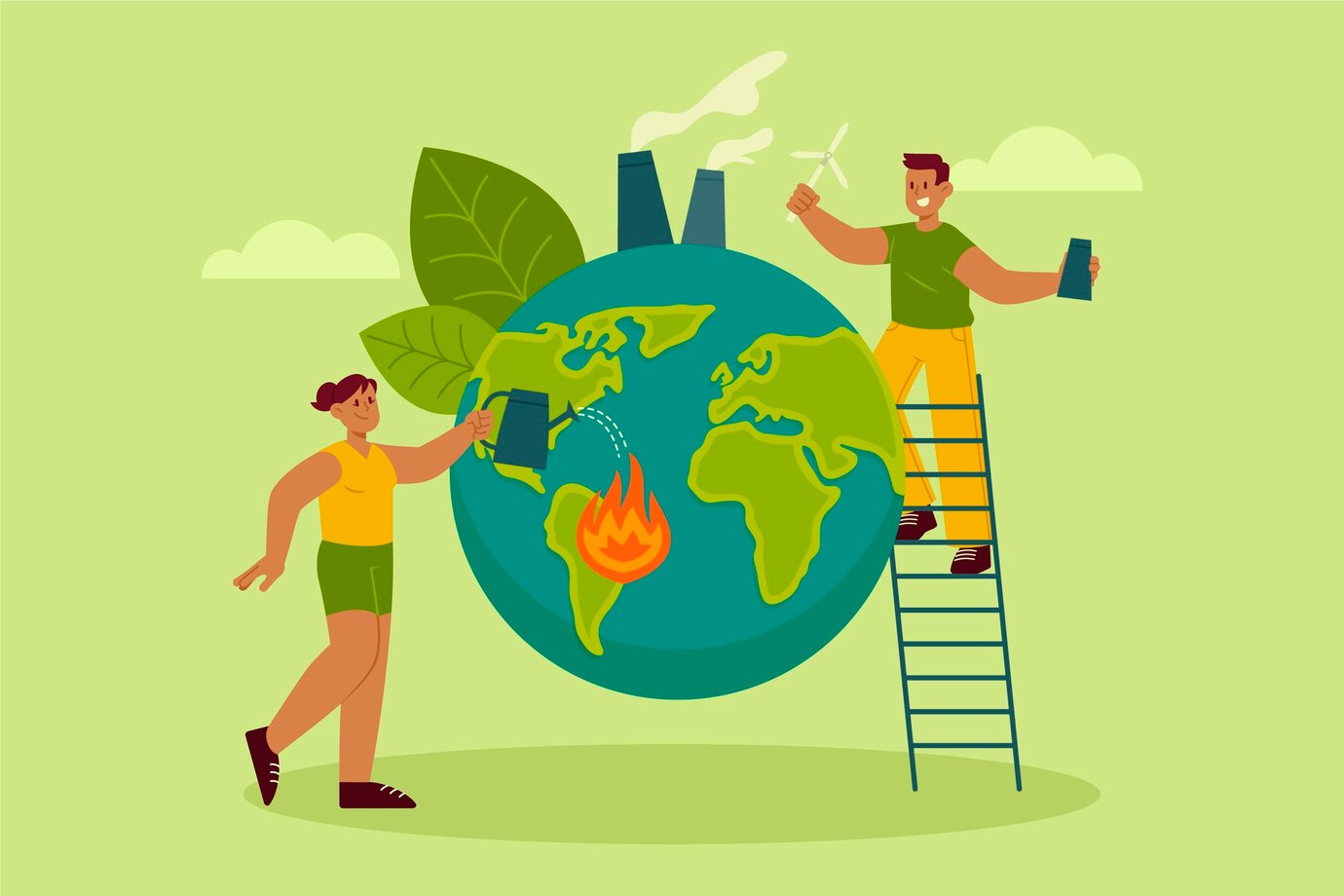Why Is Sustainable Use of Natural Resources Important?
I still remember the forest near the village where I grew up. As kids, it was our playground, our escape, and a quiet place where life just made sense. The birds, the shade, the earthy smell after rain—it was all part of the rhythm of that place.
Years later, when I went back to visit, the forest was gone.
Just a flat, dusty stretch of land stood where the trees once grew tall. Someone told me it had been cleared for development. That moment hit me like a punch to the chest. It wasn’t just the trees. It was the life, the peace, the childhood memories—all wiped away. And that’s when I truly realised that sustainable use of natural resources isn’t just about nature. It’s about identity, history, and community. It’s a human imperative.
And it’s not just my village. According to World Resources Institute Research, the world lost over 3.7 million hectares of tropical primary forest in 2023 alone. That’s equivalent to 10 football fields of forest vanishing every single minute. Forests, water, and soil—these are not infinite. They need care, balance, and respect. That’s what sustainability is all about.

In This Article
- What Are Natural Resources, and What Does Sustainability Actually Mean?
- The Urgent Need for Sustainable Practices
- The Human Cost of Unsustainable Practice
- Benefits of Sustainable Use
- Expert Insights and Quotes
- Research-Backed Solutions for Sustainable Use
- Barriers to Sustainability and How to Overcome Them
- What You Can Do: Actionable Steps
- Conclusion: A Shared Responsibility
What Are Natural Resources, and What Does Sustainability Actually Mean?
Natural resources are the raw materials that come from nature and support all human life. From the air we breathe and the water we drink to the energy we use and the food we eat, it all starts with nature.
These resources fall into two main categories:
- Renewable resources – These can replenish naturally in a relatively short time. Think sunlight, wind, water, and forests (if properly managed).
- Non-renewable resources – These take millions of years to form. Once used, they’re gone. Examples include coal, oil, natural gas, and most minerals.
So, what is sustainability?
The term “sustainability” was defined in the 1987 Brundtland Report as meeting “the needs of the present without compromising the ability of future generations to meet their own needs.” This means using resources in a way that ensures they remain available for future generations. It’s about reducing waste, using renewable resources at a rate that allows them to regenerate, and minimising our environmental impact.
For instance, consider our forests. According to the Global Forest Resources Assessment 2020, the world has lost approximately 178 million hectares of forest since 1990. While the rate of deforestation has slowed, we still lose about 4.7 million hectares annually. This loss affects biodiversity, climate regulation, and livelihoods. By practising sustainable forestry—like selective logging and replanting—we can help ensure that forests continue to provide for us and future generations.
Another pressing issue is water scarcity. A report by the Global Commission on the Economics of Water warns that by 2030, fresh water demand is expected to exceed supply by 40%, putting over half of the world’s food production at risk. This highlights the need for efficient water use and conservation practices to sustain agriculture and human consumption.
The Urgent Need for Sustainable Practices
Global Overconsumption: The Numbers
Our planet’s resources are being used up at alarming rates. Here’s a snapshot:
| Resource | Annual Consumption | Sustainable Limit | Overuse (%) |
|---|---|---|---|
| Freshwater | 4,370 billion m³ | 3,800 billion m³ | 15% |
| Forests | 15 billion trees | 5 billion trees | 200% |
| Fossil Fuels | 11 billion tonnes | ~5 billion tonnes | 120% |
(Data sourced from World Bank and UNEP, 2022)
This overuse isn’t just about numbers; it directly affects our environment and health. For instance, the extraction and processing of materials contribute to over 90% of biodiversity loss and water stress.
Real-World Case Study: The Aral Sea Disaster
A typical example of unsustainable resource use is the Aral Sea, once the fourth-largest lake globally, nestled between Kazakhstan and Uzbekistan. In the 1960s, ambitious irrigation projects diverted the rivers feeding the sea to support cotton farming. This caused the Aral Sea to lose over 90% of its volume, devastating the local fishing industry and leading to toxic dust storms that have plagued the region.
The disappearance of the Aral Sea has had profound health impacts on local communities, including increased respiratory diseases due to airborne toxins from the exposed seabed.
Efforts have been made to restore parts of the sea. Kazakhstan’s construction of the Kok-Aral Dam in 2005 led to some recovery in the North Aral Sea, with water levels rising and fish populations returning, offering a glimmer of hope.
The Human Cost of Unsustainable Practice
Health Impacts
The World Health Organisation (WHO) estimates that more than 13 million deaths globally each year are due to avoidable environmental causes, including air and water pollution. Pollution from fossil fuels increases the risk of respiratory diseases like asthma, cardiovascular conditions, and certain cancers. For instance, ambient air pollution from fossil fuel use is responsible for approximately 5.13 million excess deaths annually.
Economic Consequences
Ignoring climate change isn’t just bad for the planet—it could devastate our economies. Recent studies suggest that if we don’t act, global GDP could shrink by up to 18% by 2050 due to rising temperatures and extreme weather. That’s a massive hit that would affect jobs, industries, and livelihoods worldwide.
Case Study: Deforestation in Rondônia, Brazil
In Brazil’s Rondônia state, large-scale deforestation has severely impacted biodiversity and disrupted the water cycle. According to NASA’s Earth Observatory, the removal of forest cover has led to soil erosion and nutrient depletion, causing declining crop yields. Farmers often respond by clearing more forest to compensate, which creates a cycle of environmental degradation. Studies also show that deforestation reduces regional rainfall, worsening droughts and triggering crop failures, further threatening local economies. These changes illustrate how unsustainable land use doesn’t just harm nature—it directly affects livelihoods, health, and food security in vulnerable communities.
Benefits of Sustainable Use
1. Environmental Resilience
When we use resources sustainably, we help restore ecosystems and protect biodiversity. Healthy ecosystems are better equipped to withstand and recover from environmental stresses like climate change. For instance, preserving forests not only safeguards the diverse species that inhabit them but also maintains vital water cycles and reduces the risk of natural disasters such as floods and droughts. Nature-based solutions, like reforestation and wetland restoration, have been shown to address societal challenges effectively while providing biodiversity benefits.
2. Social Stability
Access to clean air, water, and nutritious food is fundamental to societal well-being. Sustainable resource management ensures that these essentials are available, reducing the likelihood of conflicts over scarce resources. For example, implementing sustainable agricultural practices can improve food security and support the livelihoods of local communities, fostering social cohesion and reducing migration pressures.
3. Economic Growth
Transitioning to a green economy presents significant economic opportunities. The International Renewable Energy Agency (IRENA) reports that accelerating the energy transition could create an additional 40 million jobs in the energy sector by 2050, with 18 million in renewables alone. Moreover, sustainable practices can lead to cost savings by reducing environmental and health-related expenses. For instance, a shift towards sustainable global food systems could generate up to $10 trillion in yearly benefits, enhancing human health and mitigating climate issues.
Learn More: Sustainable Water Management Practices
Expert Insights and Quotes
Dr. Vandana Shiva, a renowned environmental activist, once said:
“In nature’s economy, the currency is not money, it is life.”
— Vandana Shiva, Earth Democracy: Justice, Sustainability, and Peace
This profound statement reminds us that our planet’s resources are not just commodities for economic gain—they are the very foundation of life itself. When we exploit these resources without care, we don’t just deplete materials; we endanger the intricate web of life that sustains us all.
Dr. Johan Rockström, Director of the Potsdam Institute for Climate Impact Research, emphasises our generation’s pivotal role:
“We are the first generation with the knowledge of what we are doing to the planet, and possibly the last with a chance to fix it.”
Thanks to science and data, we now understand the damage we’re causing. That knowledge gives us power and responsibility. We’re standing at a crossroads where the decisions we make today shape the livability of our planet tomorrow.
Paul Hawken, environmentalist and author of Drawdown, describes sustainability in relational terms:
“Sustainability is about stabilising the currently disruptive relationship between Earth’s two most complex systems—human culture and the living world.”
Our modern lifestyles have created a rift between human progress and environmental health. Bridging this gap requires thoughtful actions that harmonise our needs with the planet’s well-being.
Research-Backed Solutions for Sustainable Use
Embracing Renewable Energy
Imagine a future where our homes, cars, and industries are powered entirely by clean energy. Researchers at Stanford University have developed detailed roadmaps for each U.S. state to achieve 80% renewable energy by 2030 and 100% by 2050. This ambitious plan not only aims to reduce greenhouse gas emissions but also promises significant health benefits and energy cost savings for individuals.
Advancing Sustainable Agriculture
Feeding a growing global population without depleting our natural resources is a pressing challenge. The Food and Agriculture Organisation (FAO) projects that by 2050, we’ll need to produce 70% more food to feed an estimated 9.1 billion people. Agroecology, which integrates ecological principles into farming, offers a promising solution. Studies have shown that conservation agriculture can improve soil health by 21% and maintain crop yields, even under changing climate conditions.
Implementing a Circular Economy
Our current “take-make-dispose” model is unsustainable. Transitioning to a circular economy—where products are designed for reuse, repair, and recycling—can significantly reduce waste and emissions. For instance, the Ellen MacArthur Foundation reports that adopting circular economy strategies could halve carbon dioxide emissions in Europe by 2030. This approach not only benefits the environment but also presents economic opportunities through new business models and job creation.
Barriers to Sustainability and How to Overcome Them
1. Institutional Inertia
Barrier: Established industries often resist change, clinging to traditional practices that are environmentally detrimental.
Solution: Governments can play a pivotal role by offering incentives to green startups and implementing carbon taxes. For instance, the Inflation Reduction Act in the U.S. provides nearly $370 billion in federal funding to accelerate the adoption of clean technologies, encouraging industries to shift towards sustainable practices. Similarly, the European Union is considering looser state aid rules to support clean tech projects, aiming to bolster competitiveness against global counterparts.
2. Public Awareness
Barrier: Many people lack a clear understanding of sustainability and its importance.
Solution: Integrating sustainability into education from an early age can bridge this gap. A UNESCO report revealed that by 2020, 84% of countries had incorporated sustainability education into their curricula at various levels. Schools like Discovery Elementary in Virginia serve as exemplary models, utilising solar panels and real-time energy dashboards to provide students with hands-on learning about energy consumption and conservation.
3. Economic Constraints
Barrier: The high upfront costs of green technologies can deter individuals and businesses from adopting them.
Solution: Microfinancing and international development aid can alleviate these financial burdens. Microfinance institutions (MFIs) have been instrumental in promoting green practices among micro, small, and medium enterprises (MSMEs). By integrating environmental considerations into their strategies, MFIs encourage sustainable operations. However, it’s essential to ensure that microfinance doesn’t inadvertently lead to over-indebtedness. In Cambodia, for example, the average microfinance loan has surged to about $4,200, nearly three times the average household income, raising concerns about financial sustainability.
Learn More: What is Conscious Consumerism?
What You Can Do: Actionable Steps
At Home
- Switch to LED Lights: By replacing incandescent bulbs with LED lights, you can reduce your household energy consumption significantly. LED bulbs use at least 75% less energy and last 25 times longer than traditional incandescent lighting, leading to both environmental benefits and cost savings.
- Reduce Meat Consumption: Adopting a plant-based diet can have a profound impact on the environment. Studies have shown that global adoption of plant-based diets could reduce agricultural land use by 76% and cut total global greenhouse gas emissions from food by 49%.
- Install Rainwater Harvesting Systems: Collecting rainwater for non-drinking purposes like gardening and flushing toilets can reduce your water bills by up to 40%. Basic systems are affordable, and the return on investment can be realised in as little as five years, depending on your water usage and local rainfall.
In Your Community
- Support Local Farmers: Purchasing locally grown produce supports the local economy and reduces the carbon footprint associated with transporting food over long distances.
- Participate in Tree Planting Drives: Trees provide shade, improve air quality, and enhance community well-being. Initiatives like the National Tree Growing Day in Kenya aim to plant billions of trees to combat deforestation and climate change.
- Advocate for Sustainable Urban Planning: Promoting green infrastructure in urban areas can lead to increased property values and improved air quality. For example, New York City’s green infrastructure plan is expected to provide significant economic and environmental benefits over 20 years.
At Work
- Implement Energy-Saving Policies: Encourage your workplace to adopt energy-efficient practices, such as using energy-saving appliances and reducing waste, to lower operational costs and environmental impact.
- Promote a Remote or Hybrid Work Culture: Allowing employees to work remotely can reduce greenhouse gas emissions significantly. Studies have shown that even working remotely one day per week can cut emissions by 2%, while 2 to 4 days of remote work can reduce emissions by up to 29%. andela.com
- Push for ESG (Environmental, Social, Governance) Goals in Corporate Strategy: Companies with strong ESG commitments often outperform their peers during economic downturns, as sustainability initiatives can lead to cost savings and resilience.
Conclusion: A Shared Responsibility
Sustainable use of natural resources is not a niche concern for scientists or policymakers—it’s a shared responsibility. From the dried-up wells in India to the forest fires in Australia, we are witnessing the consequences of ignoring this responsibility. But it’s not too late. Armed with awareness, empathy, and action, we can redefine progress and prosperity.
Let this not be the legacy we leave behind: a world consumed by its own consumption. Instead, let it be the turning point.







